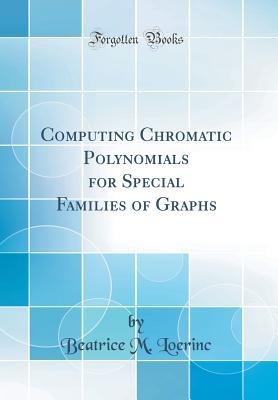Excerpt from Computing Chromatic Polynomials for Special Families of GraphsGiven a graph G, we can label its vertices Now we introduce a set of 1 colors, and assign a color to each of the n vertices so that two vertices joined by an edge do not receive the same color. Such an assignment is a proper coloring of G; by a coloring of G, we shall mean a proper coloring. Note
Download Computing Chromatic Polynomials for Special Families of Graphs (Classic Reprint) - Beatrice M Loerinc | PDF
Related searches:
Computing chromatic polynomials for special families of
Computing Chromatic Polynomials for Special Families of Graphs (Classic Reprint)
A new method for calculating the chromatic polynomial
We can calculate each of these values by using a special function that is associated with each graph, called the chromatic polynomial. For simple graphs, such as the one in figure 1, the chromatic polynomial can be determined by examining the structure of the graph. For other graphs, it is very dicult to compute the function in this manner.
A brief mention is made of the connection between the theory of chromatic polynomials and map coloring.
Use algebraic methods to compute chromatic polynomials for some class of graphs called bracelets.
The chromatic polynomial of a graph has a number of interesting and useful properties, some of which are explored in the exercises.
The chromatic polynomial is a graph polynomial studied in algebraic graph theory, a branch of mathematics. It counts the number of graph colorings as a function of the number of colors and was originally defined by george david birkhoff to study the four color problem.
28 mar 1999 the computation of the chromatic polynomial of this graph is computed by enhancing the algorithm based on the classical delete-contract.
This method allowed the author to compute the chromatic polynomial of a planar graph having 60 vertices, the so-called truncated icosa- hedron.
(although tedious) procedure that you can use to compute the chromatic polynomial of a graph.
The planar graph representing the truncated icosahedron is a cubic graph with 60 vertices and 90 edges. The computation of the chromatic polynomial of this graph is computed by enhancing the algorithm based on the classical delete-contract theorem as well as finding approaches for substantially modifying a computation tree during computation.
Chromatic polynomials are widely used in graph theoretical or chemical applications in many areas. Birkho -lewis theorem is the most important tool to nd the chromatic polynomial of any given graph.
Recursively calculate the chromatic polynomial for any graph, and explicit formulae for some special classes of graphs.
Computing chromatic polynomials for special families of graphs [loerinc, beatrice m] on amazon. Computing chromatic polynomials for special families of graphs.
It is shown how to compute the chromatic polynomial of a simplegraph an algorithm for calculating the chromatic polynomialfor any graph we choose.
Polynomial time algorithms are known for computing the chromatic polynomial for wider classes of graphs, including.
Another possible way to find the chromatic polynomial is to use basic counting methods working from the definition. P(c5, λ) is defined to be the number of ways to color the vertices of c5 in λ colors so that adjacent vertices do not receive the same color. Let the vertices of the cycle be v1, v2, v3, v4, v5 in that cyclic order.
Furthermore, we showed methods of computing the bivariate chromatic polynomial by using separators of graphs and could see that this is very complex in the bivariate case even for complete separators. Finally, we could show a connection between the bivariate chromatic polynomial and the matching polynomial of two special graph classes.
For the chromatic number, we were asking whether or not it was possible to colour to easily compute the chromatic polynomial by working vertex by vertex�.
5 feb 2014 in general, we can find the chromatic polynomial by either reducing g to compositions of null graphs or complete graphs.

Post Your Comments: